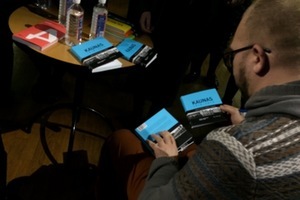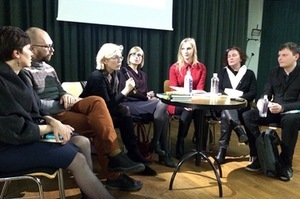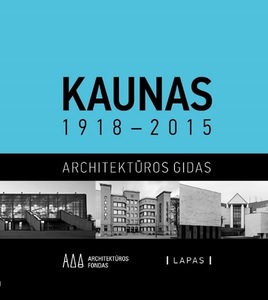Kaunas Architectural Guide - a new look at the interwar, Soviet and contemporary architecture of Kaunas 1
In brief: The creators of the first Kaunas Architectural Guide, who met in the M. K. Čiurlionis Art Gallery to present it on the 6th of March where joking that they have met to talk about a publication which does not exist anymore. Most of the thousand copies of the published book were bought during the Vilnius Book Fair and the rest were purchased by residents of Kaunas who came to the presentation of the book on Friday.
"Kaunas 1918–2015. Architecture Guide" was prepared in the course of three years and it features 243 buildings in Kaunas. Descriptions are brief; the most important information there, is about the designers and clients but it also accommodates a few sentences on the inhabitants of the house and the history of buildings. Architecture historian Jolita Kančienė said that, while working on the interwar buildings, featured in the book she was interested in the stories of the inhabitants and owners of the houses because, according to her, it also influences the style and architecture of the house.
"Kaunas will be given a European Heritage Label and it will not only help tourists but the residents of Kaunas as well, to get to know buildings ant he cultural context they live in. Maybe then, they will start appreciating this period of time more, will start looking differently at the buildings they pass by every day. I think that this book should be on a book-shelf of every Kaunas resident," said J. Kančienė. She was glad that this guide also features wooden architecture which usually is ignored in the similar publications.
Book also features the interwar period buildings that did not survive: Jewish bank, Feliksas Vizbaras Villa, Aleksandras and Jonas Vailokaičiai house and other buildings. But the architecture guide does not offer a look only at the temporary capital of interwar period. It also features Soviet buildings, among them already demolished Merkurijus department store, Kalniečiai and Vitebskas shopping centers, together with buildings built in already independent Lithuania.
"I perceive this guide as a kind of rehabilitation of the Soviet and contemporary architecture. Society is dominated by a critical approach to it," said Almantas Bružas, who worked on the objects of contemporary architecture. He encourages to view contemporary architecture not as a continuation of the old one, but as a separate period, where everything started from scratch, because there was nothing to lean against while creating new architecture. "25 years ago single-storey America was being built: kiosks, gas stations, sometimes one or two castles - of course not for defensive purpose, but residential," spoke A. Bružas.
"Why architectural guides are being published? So that a person walking down the street and knowing the history of the building would discover his connection to it, learn to know his city, would start taking care of his or neighboring house and would start responding to architecture. Second reason - architecture guides are favored not only by tourists, but by researchers and students as well, because such publications contain bibliographic information, “said J. Reklaitė, who also stressed that this guide is not only a reliable, but sometimes the only source about some of the buildings.
Kaunas Guide is second after the publication that was dedicated to Lithuanian Capital. An updated and English versions of Vilnius Guide where also published. In the future Kaunas Guide will also be translated into other languages.















